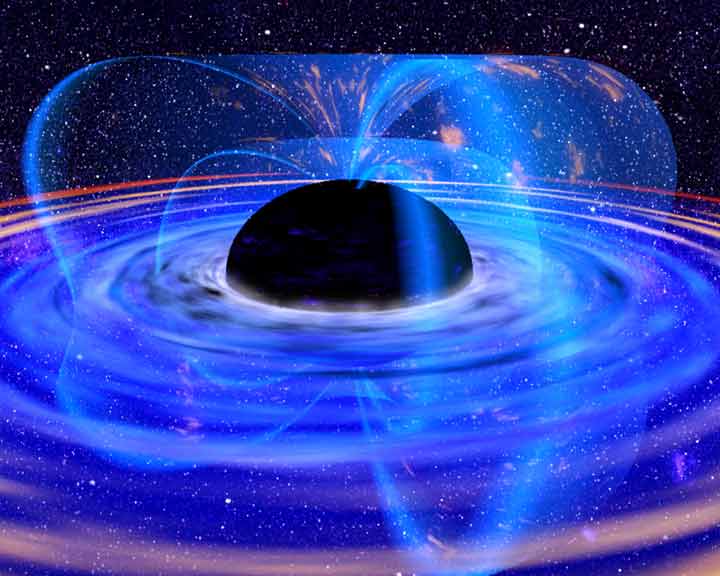Feb
11
What would you think of having a black hole in your backyard? Well, not your actual backyard — but here on Earth. How about just a tiny one? Even if you aren’t scientifically-minded, you might remember black holes from watching programs like ‘Cosmos’ or sci-fi movies like, well, ‘The Black Hole’ (1979, but about to be “reimagined”) or ‘Event Horizon’ (1997). And you know they’re scary. (The black holes, that is. Maybe the movies, too.)
Einstein theorized that space & time are warped by mass & energy, giving the effect known as “gravity”. If enough mass or energy gets forced into a sufficiently small space, the gravity becomes so strong that nothing can escape — even light disappears inside. Thus, a “black hole”. This usually happens when a hugely massive star collapses in on itself due to its own gravity. (I won’t go into details, don’t worry.) But, it’s really the ratio of mass (and/or energy) to the volume of space it’s being compressed into that matters. (No pun intended.) So, physicists of the past few decades have theorized that colliding just two microscopic particles (e.g., protons) can cause a very tiny black hole, as long as the energy was above a fundamental limit called the “Planck energy”. Or, put another way, the minimum mass required for a black hole is believed to be around the “Planck mass”, at which point general relativity “breaks down” in the face of quantum physics.
So far, however, no such collisions have been detected in nature and no particle accelerator has been able to produce the necessary conditions. Enter, the recently completed Large Hadron Collider (LHC) — a 17-miles long, elliptical tunnel under the French-Swiss border, where various experiments in high-energy physics will be performed to study areas of particle physics, quantum physics, supersymmetry, and perhaps answer some questions about the origins & structure of the universe. Among other results, particle physicists are hopeful that they will finally be able to produce mini black holes. But, not everybody thinks this is a good idea. You might remember some hoo-ha over the past couple of years over the LHC project. Despite physicists’ assurances to the contrary, some doomsayers claimed that these manmade black holes could very well proceed to suck the Earth and everything in the vicinity into them. Bye-bye Earth; so long human race! Some even petitioned the UN to stop the project.
Now, as I said, the ability to create these tiny black holes has all been speculation. Early modeling seemed to indicate it was possible, but it has since been acknowledged that certain assumptions in those calculations may have skewed the results. But, researchers from the University of British Columbia and Princeton University have just produced new simulations that gives a lot more weight to what was before just a hypothesis.
“For simplicity and to make the simulations generic, they modeled the two particles as hypothetical objects known as boson stars, which are similar to models that describe stars as spheres of fluid. Using hundreds of computers, Choptuik and Pretorius calculated the gravitational interactions between the colliding particles and found that a black hole does form if the two particles collide with a total energy of about one-third of the Planck energy, slightly lower than the energy predicted by hoop conjecture, as they report in a paper in press at Physical Review Letters.”
Of course, they still don’t know if they can create mini black holes with the LHC.
“The Planck energy is a quintillion times higher than the LHC’s maximum. So the only way the LHC might make black holes is if, instead of being three dimensional, space actually has more dimensions that are curled into little loops too small to be detected except in a high-energy particle collision. Predicted by certain theories [e.g., brane theory and superstring theory], those extra dimensions might effectively lower the Planck energy by a huge factor.”
“Waitaminute!”, you might be saying. “Why is this a good thing, if it puts us all in mortal danger?” As the physicists will tell you, black holes emit what is called “Hawking radiation”, which means they are losing mass. They shrink, or “evaporate”. For reasons I won’t get into, smaller black holes actually emit more Hawking radiation. Since the mini black holes in question would be extremely small to begin with, they would also disperse extremely quickly. For example, a black hole roughly the mass of a car would disappear in a nanosecond — not enough time to do any damage, unless perhaps you were standing unprotected nearby. Of course, once you get down to the quantum level, quantum gravitation effects could hypothetically make such a small black hole stable. Fortunately, there is no evidence to support this hypothesis (for now).
OK, it’s still a little disconcerting, but I’m not worried. In fact, I’m looking forward to what discoveries and new theories develop from the LHC experiments. Cool stuff!
UPDATE 4/22/2010: Here’s a follow-up post.
















